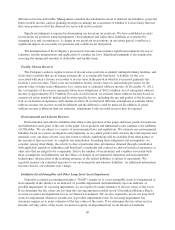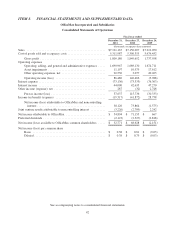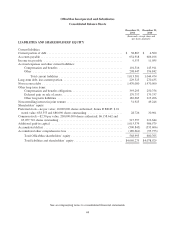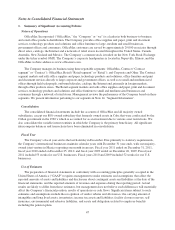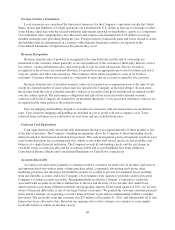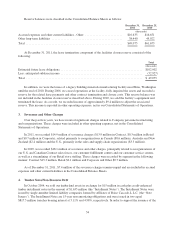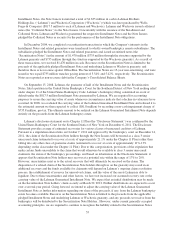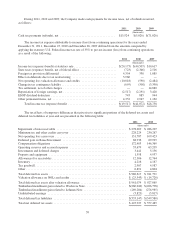OfficeMax 2011 Annual Report Download - page 81
Download and view the complete annual report
Please find page 81 of the 2011 OfficeMax annual report below. You can navigate through the pages in the report by either clicking on the pages listed below, or by using the keyword search tool below to find specific information within the annual report.At December 31, 2011 and December 25, 2010, the Company had allowances for doubtful accounts of
$3.9 million and $6.5 million, respectively.
Vendor Rebates and Allowances
We participate in volume purchase rebate programs, some of which provide for tiered rebates based on
defined levels of purchase volume. We also participate in programs that enable us to receive additional vendor
subsidies by promoting the sale of vendor products. Vendor rebates and allowances are accrued as earned.
Rebates and allowances received as a result of attaining defined purchase levels are accrued over the incentive
period based on the terms of the vendor arrangement and estimates of qualifying purchases during the rebate
program period. These estimates are reviewed on a quarterly basis and adjusted for changes in anticipated
product sales and expected purchase levels. Vendor rebates and allowances earned are recorded as a reduction in
the cost of merchandise inventories and are included in operations (as a reduction of cost of goods sold) in the
period the related product is sold.
Merchandise Inventories
Inventories consist of office products merchandise and are stated at the lower of weighted average cost or
net realizable value. The Company estimates the realizable value of inventory using assumptions about future
demand, market conditions and product obsolescence. If the estimated realizable value is less than cost, the
inventory value is reduced to its estimated realizable value.
Throughout the year, the Company performs physical inventory counts at a significant number of our
locations. For periods subsequent to each location’s last physical inventory count, an allowance for estimated
shrinkage is provided based on historical shrinkage results and current business trends.
Property and Equipment
Property and equipment are recorded at cost. The Company calculates depreciation using the straight-line
method over the estimated useful lives of the assets or the terms of the related leases. The estimated useful lives
of depreciable assets are generally as follows: building and improvements, three to 40 years; machinery and
equipment, which also includes delivery trucks, furniture and office and computer equipment, three to 15 years.
Leasehold improvements are reported as building and improvements and are amortized over the lesser of the
term of the lease, including any option periods that management believes are probable of exercise, or the
estimated lives of the improvements, which generally range from two to 20 years.
Long-Lived Asset Impairment
Long-lived assets, such as property, leasehold improvements, equipment, capitalized software costs and
purchased intangibles subject to amortization, are reviewed for impairment whenever events or changes in
circumstances indicate that the carrying amount of an asset may not be recoverable. Recoverability of assets to be
held and used is measured by a comparison of the carrying amount of an asset to the estimated undiscounted
future cash flows expected to be generated by the asset. If the carrying amount of an asset exceeds its estimated
future cash flows, an impairment charge is recognized equal to the amount by which the carrying amount of the
asset exceeds the fair value of the asset, which is estimated based on discounted cash flows. In 2011, 2010 and
2009 the Company determined that there were indicators of impairment, completed tests for impairment and
recorded impairment of store assets. See Note 5, “Intangible Assets and Other Long-lived Assets,” for further
discussion regarding impairment of long-lived assets.
Intangible Assets
Intangible assets represent the values assigned to trade names, customer lists and relationships, noncompete
agreements and exclusive distribution rights of businesses acquired. Trade name assets have an indefinite life and
49



